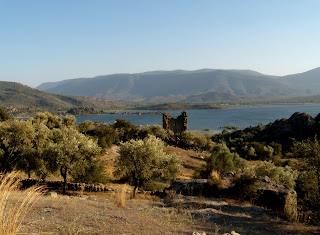Antipater first emerges from history at the side of Philip, when he became King of Macedonia
after his brother Perdiccas died
fighting Illyrians.
From what could be established, Antipater was a Macedonian nobleman, born
circa 399 BC. In his younger years, he must have accompanied King Philip (see: Macedonia Forged by Philip) during his campaigns to
impose and improve the power of Macedonia.
We actively see him from 346 BC onwards, aged 57.
When Philip
ended the successive Sacred Wars in 346 BC (see: Philip’s
campaigns east and the Fourth Sacred War – Macedonia forged by Philip II - 11), a delegation
from Athens arrived in Pella
to negotiate the peace terms. After the usual diplomacy, they reached
an agreement. Philip, however,
didn’t trust the Athenians and sent Antipater,
Parmenion, and Eurylochus
to Athens to repeat his terms of
peace. This is where Antipater
is mentioned by Arrian for the
very first time.
During the Battle of Chaironea
in 338 BC, when Alexander
commanded the left flank with his cavalry, facing the Sacred Band, he was
probably assisted by both generals Parmenion and Antipater. To seal the ensuing Common Peace, i.e., the League
of Corinth (see: High stakes at Corinth), with the Athenians, Philip sent an official embassy led by
nobody less than Alexander in
the company of Antipater and Alcimachus.
They carried the ashes of those Athenians who had fallen during the battle.
The above clearly shows how much Philip trusted Antipater. It is known that the king
formed a clique with Parmenion, Antipater,
and Attalus, who were also bound by several
intermarriages.
Antipater’s
private life is little known except that he produced an impressive number of children. His
recorded sons were Iollas, Cassander,
Pleistarchus, Philip, Nicanor, Alexarchus, and Triparadeisus. His daughters Phila, Eurydice, and Nicaea
all married generals in Alexander’s
army.
After Philip’s
assassination in 336 BC, Antipater
and Parmenion, still devoted to
their king, supported Alexander
to be elected as his heir. However, the neighboring Thracians and the Greek
states in the south had doubts about accepting the rule of this young
king and revolted. Alexander
had no choice but to confirm his kingship from the onset and attacked
the troublemakers both north and south.
As soon as he had established Macedonian control, he
turned his attention to his Asian campaign and left Pella
in 334 BC. He made sure to leave half of his troops in the capable hands of his
regent Antipater, who became
Hegemon. Besides this heavy responsibility, which included handling the
finances of the military and the navy, he was headmaster of the School of Pages.
On top of his own army, Antipater had the power to summon the militia of the Greek
city-states. He must have managed the situation with excellence because he
gathered a large number of infantry and cavalry, despite Alexander’s constant demand for
reinforcements. Antipater’s
troops were needed when he had to face Sparta’s revolt in the Peloponnese.
The first group of reinforcements was already mentioned in
332 BC while Alexander was in Memphis,
and some 500 mercenaries and 500 Thracian cavalry joined his lines. From Arrian, we know Alexander sent the funds needed to enlist
or hire such recruits. When the king was in Susa, he sent a certain Menes back to become the new governor of Syria, Phoenician, and Cilicia.
Menes received 3,000 talents in
silver with instructions to transfer as much money as Antipater needed to cover his expenses of
war against Sparta. The
general made good use of it because he emerged victorious in the decisive
battle at Megalopolis,
just north of Sparta.
Antipater was, unfortunately, seriously criticized by Olympias, who liked to interfere in all
matters. After several years, it must have become challenging for Alexander to make sense of either
version of the facts. A mother’s love is mighty, and the image of the
once-trusted commander was eventually blemished. Even if Alexander had wanted to dismiss Antipater, he had nobody to replace him –
not until a year before his death. Alexander
decided to send Craterus to replace Antipater as the new regent in Macedonia. The regent-to-be was
sent back home at the head of those veterans no longer fit for service.

Alexander called (or summoned) Antipater
to come to Babylon, but
the old general ignored the order and sent his son Cassander instead. That is a bizarre decision because Cassander was not his favorite. Whether Cassander forced his father to accept to
let him go or if it was by mutual agreement in case of the poison complot is
true, we’ll never know. We will remember that Antipater’s son, Iollas was Alexander’s cupbearer then.
Alexander left no heir or successor when he died in 323 BC. As a
result, each of his generals
claimed a part of this empire. As a matter of fact, Antipater took control of Macedonia. This, however, did not
mean peace as Antipater got
involved in the Lamian War. The Aetolians, a tribe south of Thessaly, decided to help the Athenian general Leosthenes defeat Antipater. Leosthenes managed to corner Antipater, but luckily Craterus
came to the old general aid, and the Siege of Lamia was thus broken. The war proper ended a year
later, in 322 BC, during the Battle of Crannon, when Leosthenes was killed.
Antipater died in 319 BC at the blessed age of eighty. Upon his
deathbed, he left his realm to Polyperchon and
not Cassander. The arrogant Cassander deeply resented this, and Macedonia was the scene of bitter
fights between Polyperchon and Cassander for the next decade. But that
is another story altogether.
It is quite astonishing to note how much Antipater accomplished in his later
years. From the time of the Sacred Wars that ended in 346 BC until he died in 319 BC, he lived through some twenty-five turbulent years. In our
modern world, this is the time for retirement. Amazing!















